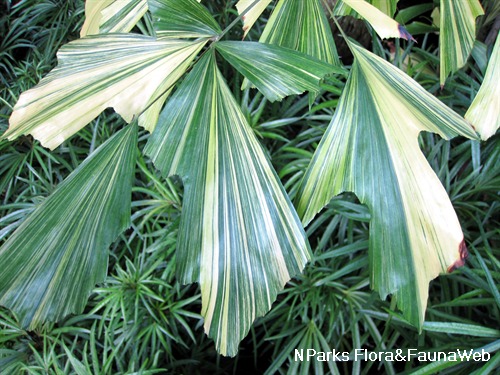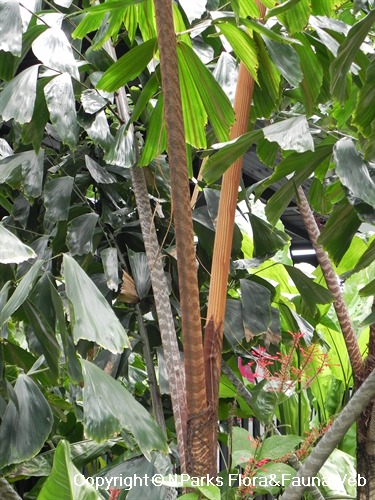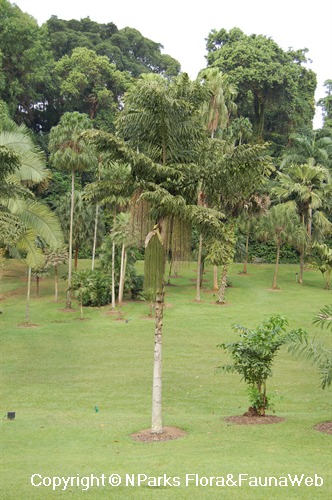
Back
Caryota mitis Lour.
| Family Name: | Arecaceae (Palmae) |
| Synonyms: | Caryota speciosa, Thuessinkia speciosa, Caryota sobolifera, Caryota javanica, Caryota nana, Caryota propinqua, Caryota furfuracea, Drymophloeus zippellii, Caryota griffithii |
| Common Name: | Fishtail Palm, Common Fishtail Palm, Burmese Fishtail Palm, Clustered Fishtail Palm, Rabok, Rebuk, Meridin, Dudok, Tukas, 短穗鱼尾葵, 叢立孔雀椰子 |
Name
Classifications and Characteristics
| Plant Division | Angiosperms (Flowering Seed Plants) (Monocotyledon) |
|---|---|
| Plant Growth Form | Palm (Clustered Habit) |
| Lifespan (in Singapore) | Perennial |
| Mode of Nutrition | Autotrophic |
| Plant Shape | Shrubby |
| Maximum Height | 10 m |
Biogeography
| Native Distribution | India, Philippines, Thailand, Malaysia, Singapore, Indonesia |
|---|---|
| Preferred Climate Zone | Tropical, Sub-Tropical / Monsoonal |
| Local Conservation Status | Native to Singapore (Least Concern (LC)) |
Description and Ethnobotany
| Growth Form | A clumping, medium-sized palm with closely-placed, slender stems that support a crowded mass of attractive, feathery fronds with their unusual fishtail leaflets. |
|---|---|
| Trunk | Stem slender, green, 5 to 15 cm in diameter, with distinct rings at wide intervals; crownshaft absent. |
| Foliage | Fronds bipinnate, ascending to spreading, 1.3 to 3 m long, 5 to 12 per stem; leaflets flat, about 10 to 18 cm long, triangular, with a jagged leaf tip and a fan-like terminal leaflet. |
| Others - Plant Morphology | Flower: Inflorescences spirally-arranged (initiating at top and moving down stem), cream, densely massed, 30 to 60 cm long; flowers in groups of 3 (2 males and 1 female). Fruit: Fruits globular, up to 1.2 cm in diameter, ripening from green to red. Makes an excellent garden palm with its beautiful, unusual leaflets that give a different texture to its surrounding. Commonly used as hedging or planted along borders due to its low, dense crown. Suitable to be planted in big parks and gardens with vast spaces for its maximum landscaping potential. Can be grown a potted plant or placed indoors. |
| Cultivation | Able to do well under full sun to semi-shade and even in shady locations. Requires moderate watering with moist, well-drained soil. Suitable soil pH ranges from 6.1 to 7.8. Has a high tolerance to high humidity but low tolerance to salt. Note: When the palm is ready to flower, it begins its flowering process from the top of the stem and continues progressively until the end of the stem. Once the lowest leaf node bears an inflorescence, the stem will die off and taken over by the side suckers. The stem should be removed once it dies off. Fruit is a irritant and is inedible as the pulp conatins calcium oxalate crystals which can result to irritation to the skin and muscous membranes.Wear gloves when handling if need be.Propagate by seeds, suckers and division. Seeds will germinate in 4 to 6 months time. Division can be achieved by dividing the clumps whereas propagating via suckers can be done by separating the suckers from the parent clump. |
| Etymology | The genus epithet 'Caryota' comes from the Greek 'caryon', a nut. The species epithet 'mitis' means unarmed, in reference to its physical presence of an unarmed palm. |
| Ethnobotanical Uses | Others: Trunk contains a starch that can be used to make sago. The bipinnate leaves are also used as thatching for huts and weaving, while the fibres from the young leaves are used as tinder to start a fire. |
Landscaping Features
| Desirable Plant Features | Ornamental Foliage |
|---|---|
| Landscape Uses | Suitable for Roadsides |
| Thematic Landscaping | Naturalistic Garden |
Fauna, Pollination and Dispersal
| Fauna Pollination Dispersal Associated Fauna | Bird-Attracting |
|---|
Plant Care and Propagation
| Light Preference | Semi-Shade, Full Sun |
|---|---|
| Water Preference | Moderate Water |
| Plant Growth Rate | Moderate |
| Rootzone Tolerance | Fertile Loamy Soils, Well-Drained Soils |
| Maintenance Requirements | Moderate |
| Propagation Method | Seed, Sucker |
Foliar
| Foliage Retention | Evergreen |
|---|---|
| Mature Foliage Colour(s) | Green |
| Mature Foliage Texture(s) | Smooth, Papery |
| Foliar Type | Compound (Bipinnate) |
| Foliar Shape(s) | Palm Fronds (Bipinnate) |
| Foliar Venation | Parallel |
| Foliar Margin | Irregularly Incised |
| Leaf Area Index (LAI) for Green Plot Ratio | 4.0 (Palm - Cluster) |
Non - Foliar and Storage
| Trunk Type (Palm) | Clustering Habit, Aboveground |
|---|---|
| Stem Type & Modification | Cane |
| Root Type | Underground (Fibrous Root) |
Floral (Angiosperm)
| Flower Colour(s) | Cream / Off-White |
|---|---|
| Flowering Habit | Monocarpic |
| Flowering Period Remarks | Once during plant's life cycle |
Fruit, Seed and Spore
| Mature Fruit Colour(s) | Red |
|---|---|
| Fruit Classification | Simple Fruit |
| Fruit Type | Fleshy Fruit |
Image Repository
Others
| Master ID | 1314 |
|---|---|
| Species ID | 2607 |
| Flora Disclaimer | The information in this website has been compiled from reliable sources, such as reference works on medicinal plants. It is not a substitute for medical advice or treatment and NParks does not purport to provide any medical advice. Readers should always consult his/her physician before using or consuming a plant for medicinal purposes. |








_lowres.jpg)
